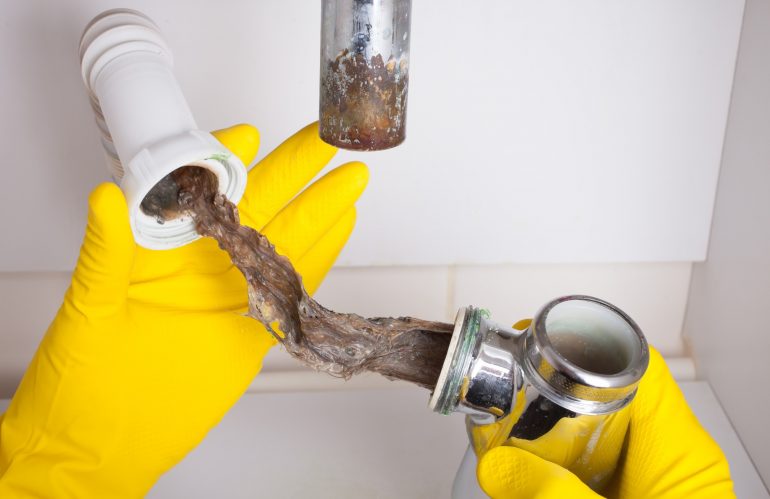Have you ever been in the shower and noticed that water is pooling around your feet? Or have you noticed your sink struggling to keep up as you wash your hands?
It’s likely caused by a clogged drain! Pay attention to how quickly the water is flowing — if it’s slow, but noticeably still moving, then your drain is only partially clogged. These are generally easy to fix clogged drains with things you have around the home.
If the water isn’t moving at all, or draining very slowly, then you have a full clog on your hands. Before you call a professional plumber, try these easy to fix clogged drains solutions.
Check out this post to get an automatic shower cleaner to clean your bathroom.
How to Fix Clogged Drains (Even Hard to Reach Ones)
Try Cleaning Out the Stopper

The first thing you should try doing is checking your drain’s stopper. It’s the small metal device that plugs your sink on command. Because of their design, they often catch a lot of debris as it gets rinsed down your sink and is the primary reason for partial clogs.
If you’re going to remove the stopper, we recommend wearing gloves. You never know what type of gunk could come up with it. Also, always wear nitrile medical-exam gloves to avoid making direct contact with high-touch surfaces that may be filled with bacteria, viruses, and all kinds of germs.
In modern sinks, they’re really easy to clean! All you need to do is unscrew it and pull it out.
If you have an older sink, it’s a little trickier but still doable. We recommend having another person with you to help. You’re going to need to look under the sink where the basin connects to the pipe. There should be a small rod with a nut and a clip attached to the pipe. That’s the stopper tether. Unscrew and remove the nut and squeeze on the clip, then have the second person lift the stopper out of the sink.
To clean it, grab some paper towel or an older rag and wipe off all the residue. You may need to do some untangling if a lot of hair is stuck to it. Then put the stopper back in (using the same steps as above), and see if that fixed the problem.
If it did, great! If not, there are a few more tricks you can try to fix clogged drains.
Try Boiling Water
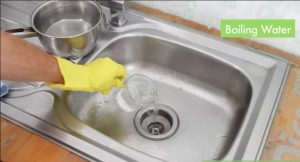
Some clogs can be remedied by pouring boiling water down the drain. You’re going to need a couple quartz of it, but nothing too extreme. The hot water may be able to remove some of the scum that’s built up over time.
Baking Soda and Vinegar Works Too
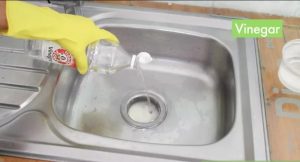
There isn’t anything baking soda and vinegar can’t be used for. Baking soda is a gentle abrasive that deodorizes, while vinegar is an acid that has the power to remove stains, mold, and rust. Combined, they form a non-toxic and bubbling solution that powers through most buildup.
To use it for clogs, all you have to do is pour half a cup of baking soda into your drain, followed by half a cup of white vinegar. Block the drain with a small rag so it doesn’t bubble out. After 15 minutes, flush it out with hot water.
If that doesn’t work, it’s time to get dirty.
Use a Bent Wire Hanger or Drain Snake
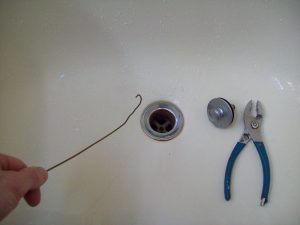
If you don’t have a drain snake (also known as a plumber’s snake), then you can make one yourself. If you have a wire hanger in your closet that you’re okay with parting with, you can turn it into a makeshift drain cleaner.
Open up the hanger — you may need pliers to help you grab it and unravel the wire — and straighten it. You can keep a little hook at the end, if you please. If you’re able to take off the drain cover and stopper, do that first. If not, you can work around them.
Carefully insert the wire hanger and start fishing for clogged debris. Keep in mind that you should be trying to pull debris out and not push it further in!
Using a Drain Snake
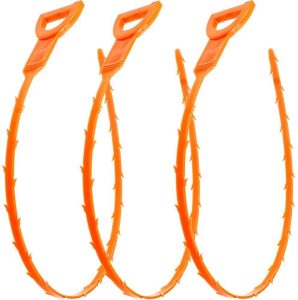
Drain snakes are tools specifically designed to pull out whatever is clogging your sink. They’re a long and flexible metal rope that has a spiral one end. Using them is pretty simple too:
- Push the spiral end of the snake into the drain until you hit a clog
- Rotate the snake until you can push the snake down again
- Remove the snake
- Run water to ensure the clog is removed
- If the water still drains slowly, repeat steps 1-4 until everything is as it should be
Cleaning a drain snake can be a little cumbersome too. You’re going to have to untangle it from the coil. The best way to do it is to get a scrubbing brush, gloves, and a place to put the debris so it’s not going right back into your drain. You can periodically rinse it off in clean water too.
When in Doubt, Call An Expert
If all of this doesn’t help, then chances are it’s something that’s deep in your pipes, or it could be your pipes themselves. It’s not your fault either — some clogs are just too tough for household DIY solutions. If that’s the case, call a professional plumber to help you out.
If you don’t have a plumbing service in mind, don’t worry. Finding a reputable company is easier than you think. When you’re doing research, check their classifications (apprentice, journeyman, or master), as well as their licensing. A good plumber should have their licenses and experience viewable online. And like always, check reviews and ask for references! Keep in mind that some reviews may not be entirely accurate, but checking them and asking your family and friends for references is essential for finding someone you trust.
Finally, a good plumber should provide timely responses and solutions. You’ll be able to find out if they do this from reviews, if they offer online forms, and if that point is stressed on their website or not. When you call them, be sure to ask for a timeline too! While clogged drains are usually not an emergency, they can be a hassle to deal with so you’ll want to go with a company that makes you feel like a priority.
As an example, look at ACE Home Services. Their website lists their experience — they’ve been in business since 1994 — reviews, services, and an FAQ to provide you with all the resources you need before you call.
When you’re doing research, be sure to look for all of those points. Remember, it’s your home. Make sure you’re putting in the hands of someone you trust.

